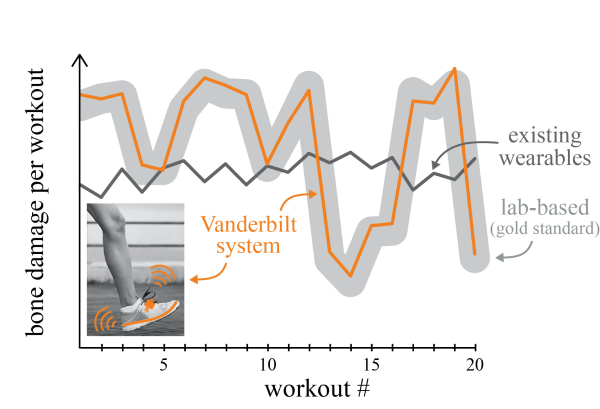A trans-institutional team of Vanderbilt engineering, data science and clinical researchers has developed a novel approach for monitoring bone stress in recreational and professional athletes, with the goal of anticipating and preventing injury. Using machine learning and biomechanical modeling techniques, the researchers built multisensory algorithms that combine data from lightweight, low-profile wearable sensors in shoes to estimate forces on the tibia, or shin bone—a common place for runners’ stress fractures.



The research builds off the researchers’ 2019 study, which found that commercially available wearables do not accurately monitor stress fracture risks. Karl Zelik, assistant professor of mechanical engineering, biomedical engineering and physical medicine and rehabilitation, sought to develop a better technique to solve this problem. “Today’s wearables measure ground reaction forces—how hard the foot impacts or pushes against the ground—to assess injury risks like stress fractures to the leg,” Zelik said. “While it may seem intuitive to runners and clinicians that the force under your foot causes loading on your leg bones, most of your bone loading is actually from muscle contractions. It’s this repetitive loading on the bone that causes wear and tear and increases injury risk to bones, including the tibia.”
The article, “Combining wearable sensor signals, machine learning and biomechanics to estimate tibial bone force and damage during running” was published online in the journal Human Movement Science on Oct. 22.
The algorithms have resulted in bone force data that is up to four times more accurate than available wearables, and the study found that traditional wearable metrics based on how hard the foot hits the ground may be no more accurate for monitoring tibial bone load than counting steps with a pedometer.

Bones naturally heal themselves, but if the rate of microdamage from repeated bone loading outpaces the rate of tissue healing, there is an increased risk of a stress fracture that can put a runner out of commission for two to three months. “Small changes in bone load equate to exponential differences in bone microdamage,” said Emily Matijevich, a graduate student and the director of the Center for Rehabilitation Engineering and Assistive Technology Motion Analysis Lab. “We have found that 10 percent errors in force estimates cause 100 percent errors in damage estimates. Largely over- or under-estimating the bone damage that results from running has severe consequences for athletes trying to understand their injury risk over time. This highlights why it is so important for us to develop more accurate techniques to monitor bone load and design next-generation wearables.” The ultimate goal of this tech is to better understand overuse injury risk factors and then prompt runners to take rest days or modify training before an injury occurs.
“The machine learning algorithm leverages the Least Absolute Shrinkage and Selection Operator regression, using a small group of sensors to generate highly accurate bone load estimates, with average errors of less than three percent, while simultaneously identifying the most valuable sensor inputs,” said Peter Volgyesi, a research scientist at the Vanderbilt Institute for Software Integrated Systems. “I enjoyed being part of the team. This is a highly practical application of machine learning, markedly demonstrating the power of interdisciplinary collaboration with real-life broader impact.”
This research represents a major leap forward in health monitoring capabilities. This innovation is one of the first examples of a wearable technology that is both practical to wear in daily life and can accurately monitor forces on and microdamage to musculoskeletal tissues. The team has begun applying similar techniques to monitor low back loading and injury risks, designed for people in occupations that require repetitive lifting and bending. These wearables could track the efficacy of post-injury rehab or inform return-to-play or return-to-work decisions.
“We are excited about the potential for this kind of wearable technology to improve assessment, treatment and prevention of other injuries like Achilles tendonitis, heel stress fractures or low back strains,” said Matijevich, the paper’s corresponding author. The group has filed multiple patents on their invention and is in discussions with wearable tech companies to commercialize these innovations.
This research was funded by National Institutes of Health grant R01EB028105 and the Vanderbilt University Discovery Grant program.